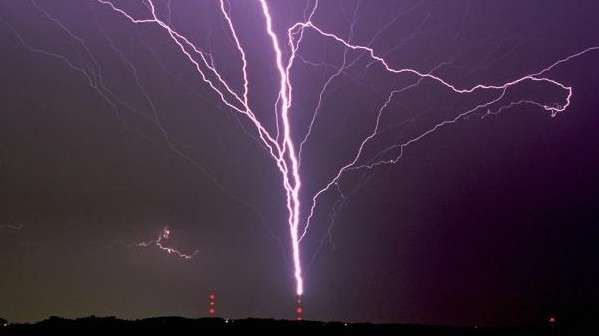Upside-down lightning strikes

Upward lightning strikes initiate on the ground and head skyward. These discharges, which usually begin at the top of tall and slender structures, pose a real risk for wind turbines. An EPFL study analyzes the mechanisms underlying this poorly understood phenomenon.
Is lightning born of an angry sky? Not always. In some circumstances, it can also be initiated from the ground. Upward-moving discharges can easily be distinguished from downward ones by the inverted branches of the lightning which point to the clouds rather than the ground. Upward strikes are a poorly understood phenomenon and mainly occur where tall and slender structures are located on high ground. A researcher from EPFL's Electromagnetic Compatibility Laboratory (EMC) took an interest in this topic, analyzed it and ended up writing his thesis on it. The results of his research were published in a recent issue of the Journal of Atmospheric and Solar-Terrestrial Physics.
"Ground-to-cloud lightning strikes have been observed since the 1930s, but it is only recently, with the growing use of wind turbines, that it has become a real concern," said Aleksandr Smorgonskii, a doctoral student at the EMC Lab.
Despite their power, these discharges are harmless when it comes to communication antennas and skyscrapers. These metallic structures, equipped with lightning rods, conduct the electricity from the ground to the top where they escape without causing any damage. The same is not true of wind turbines, however.
Blades destroyed
"In order to optimize wind capture, wind turbines are commonly built in the mountains – on crests no less," said Smorgonskii. "The combination of a tall structure and high altitude corresponds exactly to the conditions in which ground-to-cloud lightning forms. If the tower is made of metal, the blades are the weak point. Not only are they long and light, and thus fragile, but they are also made of non-conductive composite materials. As a result, they are often damaged, if not destroyed, by the extreme electrical charge."
Smorgonskii's' idea was to analyze the mechanisms underlying this type of lightning strike in order to adapt the design of wind farms to account for these risks. He analyzed data that had been recorded over the course of around 15 years at two mountaintop radio transmitters, one on Gaisberg Mountain in Austria and the other on Säntis Mountain in central Switzerland. The latter transmitter, perched over 2,500 meters above sea level, is known for being the most lightning-prone spot in Europe.
Thunderstorm activity
Among the most interesting figures revealed by the study is the fact that, in one year, these high structures can record up to 100 more upward than downward strikes. It also appears that most ground-to-cloud strikes occur in the absence of existing thunderstorm activity. Using the Europe-wide lightning-detection system Euclid, Smorgonskii determined, for a given upward strike, whether a downward strike had taken place within a 50-kilometer radius less than one second before. This was true in only 15% of cases. Which means that more than 80% of ground-to-cloud strikes are initiated independently.
"Weather conditions, especially the temperature and its distribution in the air, also appear to be an important factor in triggering these lightning strikes," said Smorgonskii. Determining the exact nature of the risks will require careful study of both geographical and climatological data specific to each site.
Provided by Ecole Polytechnique Federale de Lausanne





















